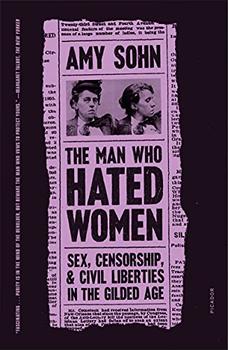Summary | Excerpt | Reviews | Beyond the Book | Readalikes | Genres & Themes | Author Bio

Critics' Opinion:
Readers' Opinion:
First Published:
Jul 2021, 400 pages
Paperback:
Jul 2022, 400 pages
 Book Reviewed by:
Book Reviewed by:
Rose Rankin
Buy This Book
For someone as powerful and well-connected as he was, Comstock was extremely sensitive to criticism. Radical newspapers filled their pages with anti-Comstock screeds, and he attended atheist and freethinker meetings to shout at these detractors. He was a zealot who drew no distinction between sex workers and sex radicals, between dealers of lewd postcards and gynecologists. His interest in women's health and well-being stopped at contraception and abortion, which he often conflated. The man who did more to curtail women's rights than anyone else in American history had nearly no understanding of reproduction; he believed a fetus could form seconds after unprotected sex. Though he revered his mother, and all Christian mothers, he despised the midwives and abortionists who helped women in trouble and who saved them from destitution and death. To his mind these practitioners were evil, manipulative, and in it for the money. He did not believe he was a man who hated women. He believed his work was to save the young and innocent from those out to get them.
Sitting in the Cairo Street Theatre watching the dancers, he was as transformed as Craddock had been. He felt that he was seeing "the most shameless exhibition of depravity" he had witnessed in his work. Calling on the Board of Lady Managers, he insisted that they visit the "pestilential places." Three managers toured the Middle Eastern theaters. The board issued a report to the fair's director-general, George R. Davis, requesting that he shut down all the belly dances. One manager, Mrs. Barker, wrote, "I would sooner lay my two boys in their graves than that they should look upon the sights I saw yes'erday." An investigative committee was formed, with Comstock at the head.
In an interview with Joseph Pulitzer's popular and salacious New York World, Comstock said the dancers defiled "the magnificence of that Columbian Exposition" with their "nastiness." He rose from his chair and began to demonstrate, waving his arms above his head. As the journalist described it, "He is a pretty stout man and the performance was very interesting, but not at all libidinous. He writhed his shirt-sleeved arms over his head and made his ginger-colored side-whiskers shiver in the air." As Comstock bent back to demonstrate further, he nearly fell over. An attendant in the room shook his head and clucked.
On August 5, Davis ordered the shuttering of all of the Oriental dances, which were performed at a few other theaters in addition to Cairo Street, until new regulations could be established. The manager of the Persian Palace demanded an order in writing, and informed the press that he would ignore such an order even if he received it. The dance could be stopped only by force, he said, and then he would get an injunction and sue for damages.
Despite national controversy and Comstock's intervention, ultimately the only alteration made to the fair's belly dancing was costuming: the dancers swapped their gauze blouses for thin woolen undershirts. The vice hunter had lost in Chicago. But he would not forget the dancers, and would have four of them arrested and fined when they came to New York that winter. New York, after all, was Comstockland.
* * *
By the time Ida Craddock traveled to the World's Fair, there was plenty of sex information for progressive, curious young people. The German psychiatrist Richard von Krafft-Ebing's Psychopathia Sexualis, which coined the terms sadism and masochism, had been translated into English a year earlier. In 1894, Havelock Ellis, an English psychologist and doctor, would publish a volume on human sexuality titled Man and Woman: A Study of Human Secondary Sexual Characters. And the Illinois physician Dr. Alice B. Stockham's popular Tokology: A Book for Every Woman (1883) provided anatomical details about male and female bodies, and promoted strategies for coping with labor pains. Physicians and free lovers wrote manuals on hygiene, child-rearing, pregnancy, and better sex—many advertised in radical journals such as New York's Truth Seeker, edited by D. M. Bennett, and the Kansas-based freethinker and free love journal Lucifer, the Light-Bearer, edited by Moses Harman.
Excerpted from The Man Who Hated Women by Amy Sohn. Copyright © 2021 by Amy Sohn. Excerpted by permission of Farrar, Straus & Giroux. All rights reserved. No part of this excerpt may be reproduced or reprinted without permission in writing from the publisher.





The Flower Sisters
by Michelle Collins Anderson
From the new Fannie Flagg of the Ozarks, a richly-woven story of family, forgiveness, and reinvention.

The House on Biscayne Bay
by Chanel Cleeton
As death stalks a gothic mansion in Miami, the lives of two women intertwine as the past and present collide.

The Funeral Cryer by Wenyan Lu
Debut novelist Wenyan Lu brings us this witty yet profound story about one woman's midlife reawakening in contemporary rural China.
Your guide toexceptional books
BookBrowse seeks out and recommends the best in contemporary fiction and nonfiction—books that not only engage and entertain but also deepen our understanding of ourselves and the world around us.